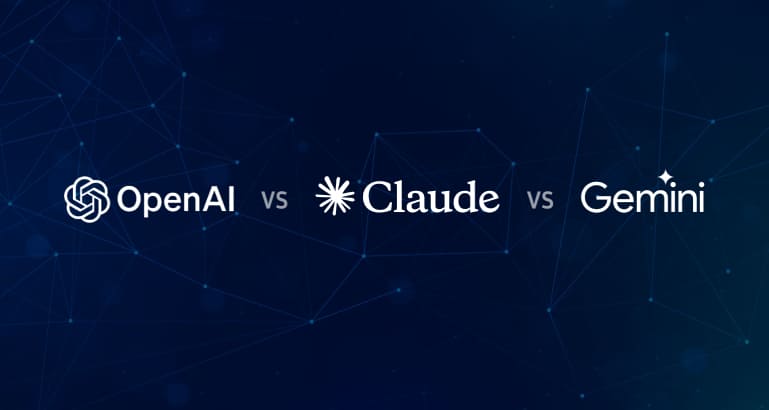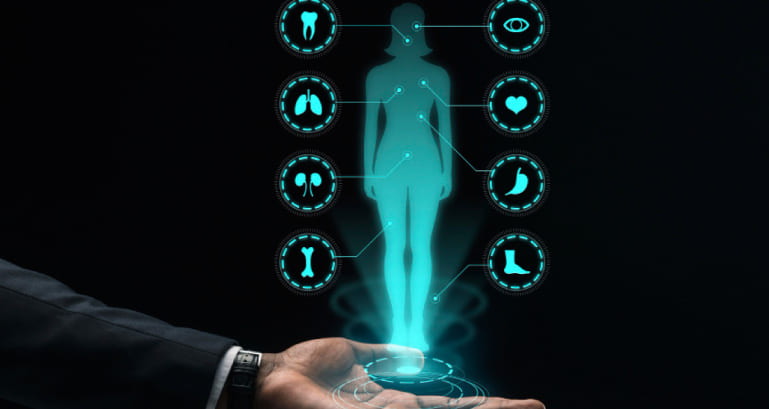Comparing Leading AI Models for Clinical Text Processing
The advent of modern artificial intelligence has ushered in a new era of technological advancement, with large language models (LLMs) at the forefront of this revolution. As businesses and individuals grapple with the challenge of selecting the right AI tool for their needs, three major players have emerged in the LLM space: OpenAI's GPT, Anthropic's Claude, and Google's Gemini.
Each of these models offers unique capabilities and strengths, but navigating their differences can be daunting. This blog aims to provide a comprehensive comparison of these three leading LLMs, exploring their technological foundations, features, and performance across various use cases. By delving into the complexities of these models, we hope to equip you with the knowledge needed to make informed decisions about which LLM best suits your specific requirements.
Let us first start by understanding what Generative AI is and how it can benefit you.
What is Generative AI?
Generative AI refers to artificial intelligence systems capable of creating new content, including text, images, audio, and even code. These systems learn patterns from vast amounts of training data and use that knowledge to generate novel outputs that mimic human-created content.
The history of generative AI can be traced back to the 1950s with early experiments in computer-generated poetry and music. However, it's only in recent years that we've seen exponential growth in capabilities, primarily due to advances in deep learning and the availability of massive datasets. OpenAI set ablaze the recent AI storm when they launched ChatGPT to the public in November 2022.
Looking to the future, generative AI is poised to revolutionize industries ranging from creative content production to software development. In the enterprise context, it promises to automate routine tasks, augment human creativity, and unlock new avenues for innovation and problem-solving across a multitude of fields. Gartner even predicts that by 2026, 75% of businesses will use generative in some capacity.
Benefits of GenAI
Generative AI offers a wide array of benefits across various domains:
Content Creation: GenAI can rapidly produce high-quality written content, from marketing copy to technical documentation. For example, a content marketing team could use an LLM to generate multiple variations of ad copy in seconds, allowing for rapid A/B testing.
Code Generation: In software development, GenAI can assist programmers by generating boilerplate code, suggesting optimizations, and even creating entire functions based on natural language descriptions. This can significantly speed up development cycles and reduce errors.
Data Mining: GenAI models can process and summarize large volumes of unstructured data, extracting key insights. For instance, a financial institution could use an LLM to analyze thousands of customer reviews and generate actionable reports on sentiment and emerging trends.
Language Translation: Advanced LLMs can perform near real-time, high-quality translations across multiple languages, breaking down communication barriers in global business.
Creative Ideation: In fields like advertising or product design, GenAI can serve as a brainstorming partner, generating novel ideas and concepts that humans can refine and develop further.
Now that we have understood what Generative AI is and how it can benefit you, let us understand how it works and what technology is behind it.
Technological Foundations of Generative AI
The power of modern generative AI systems stems from several key technological advancements:Natural Language Understanding
At the core of LLMs is their ability to understand and process human language. This is made possible through Natural Language Understanding. Natural language understanding (NLU) is essential for chatbots to interpret and respond to human text accurately. This is achieved through techniques like:
Transformer Architecture: Introduced in 2017, transformers use self-attention mechanisms to process input sequences in parallel, capturing long-range dependencies in text.
Tokenization: Breaking down text into smaller units (tokens) that the model can process efficiently.
Contextual Embeddings: Representing words and phrases as high-dimensional vectors that capture semantic meaning and context.
Multimodal AI Capabilities
Unlike traditional models that tend to focus on a single data type, multimodal AI can process and integrate information from multiple data types, including text, images, audio, and video. Advanced LLMs can also process and generate content across multiple modalities:
Vision-Language Models: Integrating computer vision techniques with natural language processing to understand and describe images.
Audio Processing: Incorporating speech recognition and audio analysis capabilities to work with spoken language and sound.
Cross-Modal Learning: Enabling models to transfer knowledge between different modalities, enhancing overall understanding and generation capabilities.
Machine Learning
Machine learning is another core capability of AI that helps it to develop and bring out better results. The development of generative AI relies heavily on machine learning techniques like:
Unsupervised Learning: Training on vast amounts of unlabeled data to discover patterns and structures.
Supervised Learning: Applying knowledge gained from one task to improve performance on related tasks.
Reinforcement Learning: Fine-tuning models based on feedback and rewards to optimize performance for specific objectives.
With the knowledge of what GenAI is and how it works, it is time for us to explore the top LLMs in the market right now.
Top 3 LLMs
In the era of generative AI, LLMs have emerged as the top choice for many users. This is because they offer a wide range of features for automation covering a diverse range of use cases. It has made life easier for many businesses and individuals. Let us explore the top 3 LLMs that are the talk of the market right now.
OpenAI GPT
The Generative Pre-trained Transformer (GPT) series, developed by OpenAI, has been at the forefront of LLM innovation. GPT models use a decoder-only transformer architecture and are trained on a diverse corpus of internet text. Starting with GPT-1 in 2018, each iteration has brought significant improvements in scale and capabilities. GPT-3, released in 2020, was a major breakthrough, and GPT-4, launched in 2023, further pushed the boundaries of what's possible with LLMs.
Features and Benefits:
- GPT-4 is estimated to have over 1 trillion parameters.
- Strong few-shot learning capabilities.
- Multimodal input processing (text and images) in GPT-4.
- Adaptive output styles to match user preferences.
- Robust performance across a wide range of tasks, from creative writing and coding to complex problem-solving.
Anthropic Claude
Claude is an AI assistant developed by Anthropic , a company focused on building safe and ethical AI systems. Claude is designed to be helpful, harmless, and honest. Anthropic was founded by former OpenAI researchers in 2021. Claude was first introduced in 2022 and has since seen several iterations, with Claude 3 being the latest version.
Features and Benefits:
- Large context window (200,000 tokens in Claude 3 Opus).
- Strong performance in tasks requiring reasoning and analytical thinking.
- Built-in safeguards to promote ethical behavior and avoid harmful outputs.
- Ability to handle complex, multi-step instructions.
- Excels at tasks like document analysis, coding, and mathematical problem-solving.
Google Gemini
Gemini is Google's most advanced AI model, designed to be multimodal from the ground up. It represents Google's response to competitors in the LLM space. Announced in December 2023, Gemini builds on Google's extensive experience in AI and machine learning, including work on models like BERT and LaMDA.
Features and Benefits:
- Native multimodal capabilities, seamlessly integrating text, image, video, and audio inputs.
- Optimized for efficiency, with different versions (Ultra, Pro, and Nano) for various use cases.
- Strong performance in reasoning and coding tasks.
- Integrated with Google's suite of tools and services.
- Designed to scale efficiently across different types of hardware.
That was a brief overview of each LLM, let us continue to discern their differences further by analyzing their differences.
GPT-4o vs Claude 3 Opus vs Gemini 1.5 Pro
The following table compares the differences between three different multimodal AI models: GPT-4o, Gemini 1.5 Pro, and Claude 3 Opus.
| Features | GPT-4o | Claude 3 Opus | Gemini 1.5 Pro |
|---|---|---|---|
| Launch | Nov 2023 | Mar 2024 | Feb 2024 |
| Knowledge Cutoff | Dec 2023 | Aug 2023 | N/A |
| Context Window | 128K tokens | 200k tokens | 128k tokens (1M in preview) |
| Parameters | 1.76 trillion estimated | 2 trillion estimated | 1.6 trillion estimated |
| Language Support | 26+ languages | 12+ languages | 38+ languages |
| Pricing (per 1m tokens) | $5 input, $15 output | $15 input, $75 output | $3.5 input, $10.5 output |
To further understand which LLM will suit your needs the best, let us analyze and deduce which LLM is best suited for particular use cases.
Benchmarking for Use Cases
Each LLM has its strengths and weaknesses. The most suitable LLM for a particular use case depends on what they bring to the table and how they perform and respond differently.
The following table aims to represent how these LLMs perform across various benchmarks.
| Model | MMLU (Undergrad level) | GPQA (Postgrad level) | MATH (Problem-solving) | HumaEval (Code) | MGSM (Multilingual Math) | DROP (Reasoning) |
|---|---|---|---|---|---|---|
| GPT-4o | 88.7 | 53.6 | 76.6 | 90.2 | 90.5 | 83.4 |
| Claude Opus 3 | 86.8 | 50.4 | 60.1 | 84.9 | 90.7 | 83.1 |
| Gemini 1.5 Pro | 83.7 | N/A | 53.2 | 74.4 | 79.0 | 82.4 |
Let us explore different use cases one by one to understand which LLM is better suited for your use case.
Creative Writing
GPT-4o demonstrates strong capabilities in creative writing tasks, generating coherent and contextually appropriate content. Claude 3 Opus excels in producing longer-form content with a more natural tone. Gemini 1.5 Pro stands out for its human-like writing style and ability to offer creative suggestions.
Creative Writing
GPT-4o demonstrates strong capabilities in creative writing tasks, generating coherent and contextually appropriate content. Claude 3 Opus excels in producing longer-form content with a more natural tone. Gemini 1.5 Pro stands out for its human-like writing style and ability to offer creative suggestions.
Maths and Logical Reasoning
GPT-4o shows superior performance in complex mathematical and logical reasoning tasks, often outperforming human experts. Claude 3 Opus demonstrates strong capabilities but falls slightly behind GPT-4o in advanced problems. Gemini 1.5 Pro shows competence but may struggle with more complex instructions.
Coding
Both GPT-4o and Claude 3 Opus exhibit strong coding abilities, with GPT-4o excelling in error correction and Claude 3 Opus offering more comprehensive outputs in a single prompt. Gemini 1.5 Pro, while capable, may face challenges with advanced coding tasks.
Image Generation
GPT-4o can generate images through DALL-E integration. Claude 3 Opus cannot generate images but can analyze them effectively. Gemini 1.5 Pro has image generation capabilities but may face limitations or inconsistencies.
Data Mining
Claude 3 Opus demonstrates superior performance in analyzing and extracting information from large documents like PDFs. GPT-4o and Gemini 1.5 Pro can handle these tasks but may provide less comprehensive outputs.
IQ Tests
Recent tests suggest Claude 3 Opus has achieved an IQ score of 101, surpassing the average human IQ. GPT-4o scored 85, while Gemini Advanced (a different version from 1.5 Pro) scored 76.
Response Times
Gemini 1.5 Flash, an optimized version of Gemini, offers the fastest response times. GPT-4o provides quicker responses compared to its predecessors, while Claude 3 Opus balances speed with comprehensive outputs.
Security and Transparency
Anthropic emphasizes safety and transparency with Claude 3 Opus, providing more information about its architecture and training process. GPT-4o and Gemini 1.5 Pro have faced criticism for lack of transparency regarding their inner workings and training data.
There are plenty more use cases of Generative AI across industries but we hope these detailed comparisons and deductions helped you to not only understand the different LLMs in detail but also ascertain the best fit for your unique needs.
Conclusion
We hope this detailed comparison has helped you discern and understand the differences among these LLMs. Before choosing an LLM for your specific needs, consider factors such as the required task complexity, output length, and ethical considerations as well. It's also worth experimenting with multiple models to find the best fit for your use case.
As these models continue to advance, we can expect even more impressive capabilities and applications in the future. Stay informed about the latest developments and be prepared to adapt your AI strategy as the technology evolves.
About Author
Dr. Phaneender Aedla
Dr. Phaneender Aedla has over 24 years of experience in handling and managing petabyte-scale data systems. He blends deep technical acumen with strategic vision, and aims to drive intelligent, sustainable innovation through co-creative partnerships that unlock true business value.








